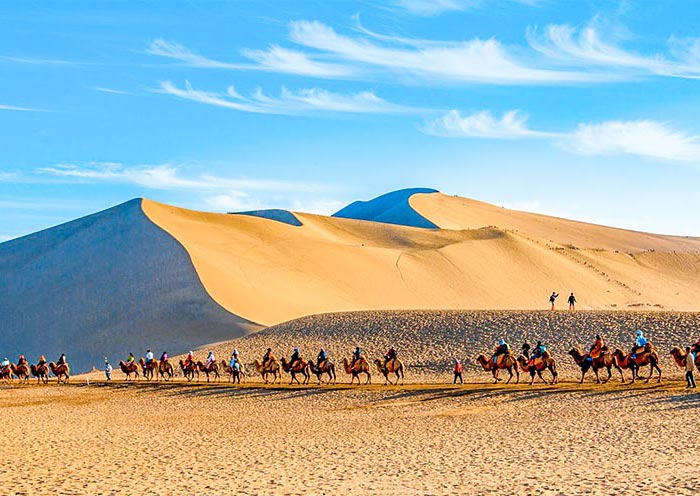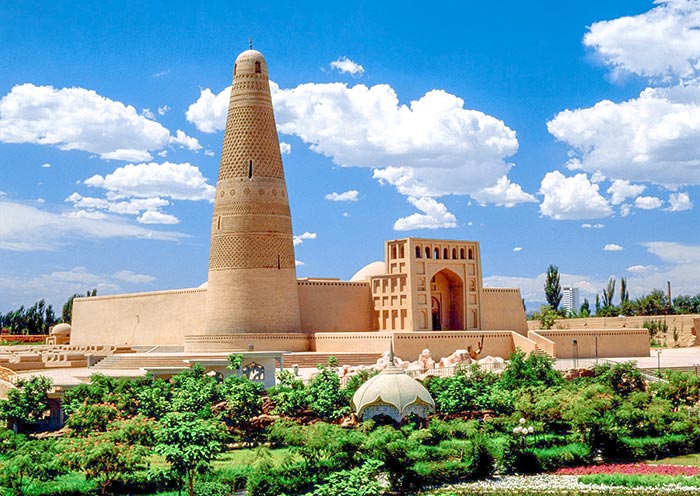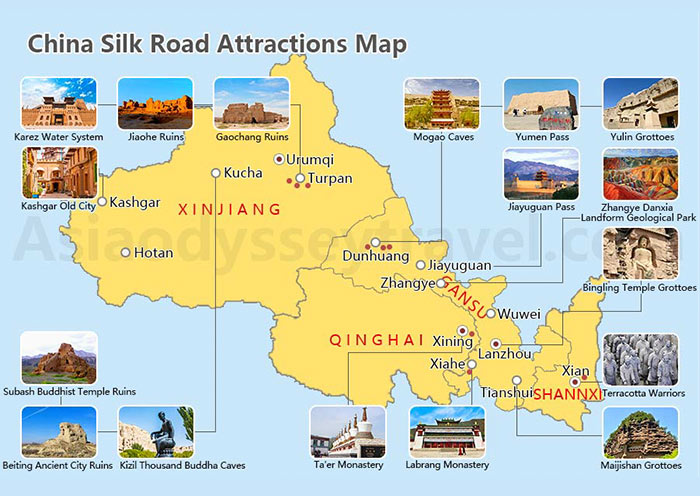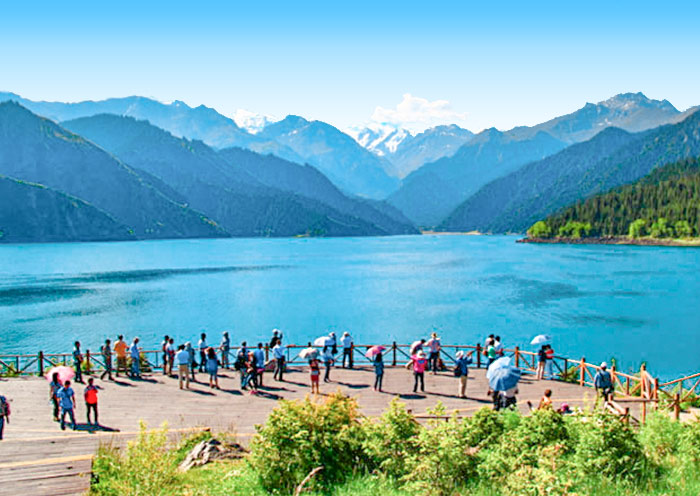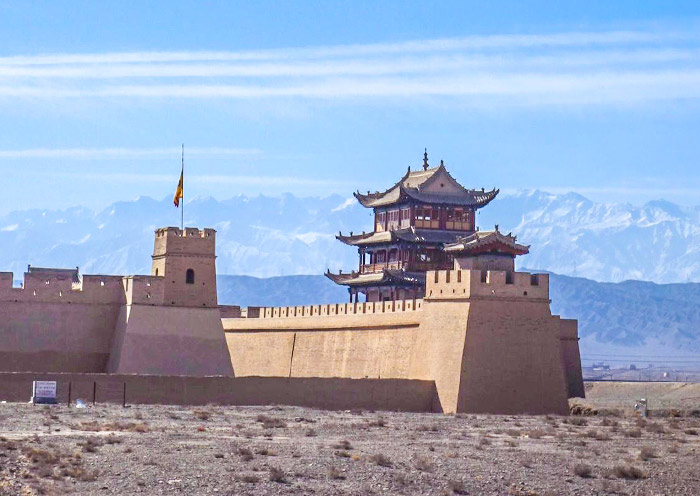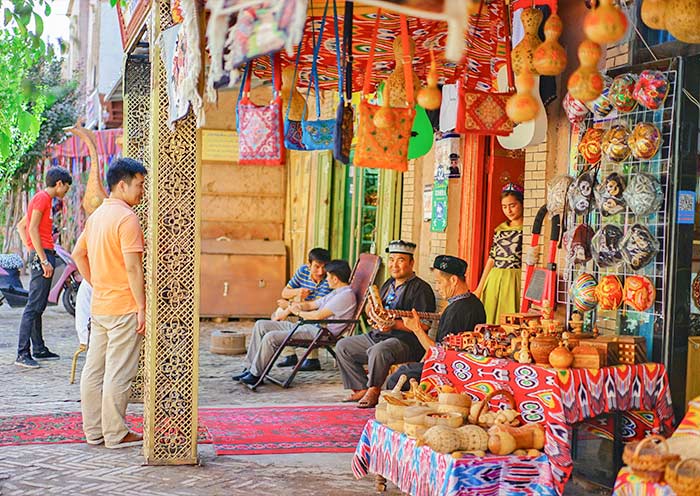1. Terracotta Army, Xi'an: Attraction Embodies the Dynasty Set Stage for Silk Road
- Location: Lintong District, Xi'an, Shaanxi Province, China
- Distance from Xi'an city center: Approximately 24 miles (39 km)
The Terracotta Warriors, discovered in 1974 near Xi'an, Shaanxi Province, is one of the most significant archaeological highlight finds in history. This vast collection of life-sized statues was created to accompany Emperor Qin Shi Huang in the afterlife, showcasing the extraordinary craftsmanship and artistic mastery of the Qin Dynasty.
As a UNESCO World Heritage Site, the Terracotta Army reflects not only the emperor's desire for immortality but also the grandeur of the Qin Dynasty, which laid the groundwork for the future development of the Silk Road.

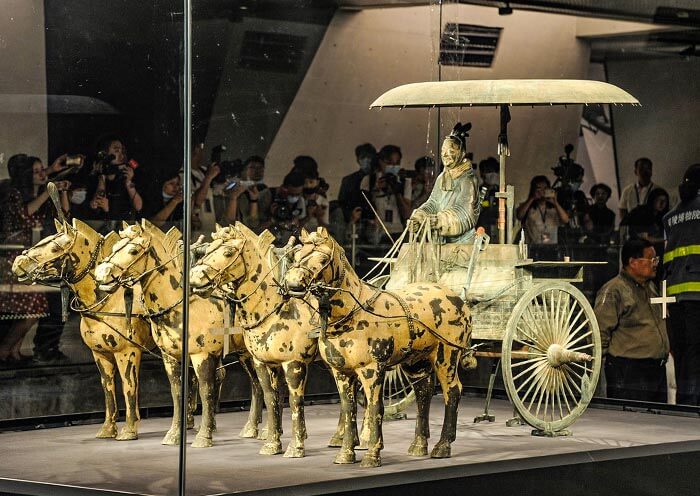
Highlights:
Historical Significance: The Terracotta Army consists of over 8,000 individual figures, including soldiers, horses, chariots, and other figures, each uniquely crafted with distinct facial features and expressions.Check out How to Visit Terracotta Warriors.
Cultural Context: The intricate details of each figure, including their weapons and armor, exemplify the sophisticated craftsmanship of the time. Techniques and artistic styles seen in the Terracotta Army influenced later artistic expressions that spread along the Silk Road, further enriching cultural exchanges between China and other regions of Asia.
2. Xi'an Ancient City Wall, Xi'an: The Very Starting Point of Silk Road
- Location: Xi'an, Shaanxi Province, China
- Distance from Xi'an city center: Approximately 1 mile (1.6 km)
Xi'an City Wall is a must visit attraction in along the Silk Road. As the starting point of the Silk Road, Xi'an City Wall stands as a testament to the city's historical significance. Originally built to protect the capital of the Tang Dynasty, it symbolizes the security and stability that facilitated trade and cultural exchange along the Silk Road.
Today, visitors can walk or cycle along the wall, immersing themselves in the rich history while enjoying panoramic views of the city's skyline, much like ancient traders who surveyed their route from these fortifications.


Highlights:
Historical Significance: Walk or cycle along the well-preserved walls that once safeguarded merchants traveling between East and West.
Panoramic Views: Enjoy stunning vistas of both ancient and modern Xi'an from atop the wall.
Cultural Events: Experience various festivals held on the wall, celebrating the city's rich Silk Road history and everyday life today in Xi'an.
3. Giant Wild Goose Pagoda, Xi'an: Cultural Treasures Brought Back along Silk Road
- Location: Xi'an, Shaanxi Province, China
- Distance from Xi'an city center: Approximately 2.5 miles (4 km)
This iconic pagoda, brought to prominence by the monk Xuanzang(玄奘法师), houses the cultural treasures and Buddhist scriptures transported along the Silk Road.
Today this Pagoda is a must-visit Xi'an Attractions and Silk Road attraction. You can explore the serene temple grounds, mirroring the spiritual journeys of ancient pilgrims who sought enlightenment and knowledge.


Highlights:
Architectural Marvel: Explore the intricate design and the stories behind the pagoda's construction.
Xuanzang's Journey: Learn about Xuanzang's pilgrimage to India and his role in bringing Buddhism to China. The routes he took overlapped with the Silk Road, or shall we say it was the very Silk Road itself that Xuanzang traveled.
Music Fountain Performance at Night: Now as a Top Attraction along the Silk Road the Pagoda offers tourist-friendly amenities and Night Fountain Shows.
4. Muslim quarter, Xi'an: Diversity & Culture Exchange Silk Road Brought into China
- Location: Xi'an, Shaanxi Province, China
- Distance from Xi'an city center: Approximately 1 mile (1.6 km)
The vibrant Muslim Quarter reflects the diverse influences from Silk Road trade, as culture being exchanged and communities coming together the Chinese Hui community started to thrive in the heart of Tang Dynasty, Xi'an. So this Silk Road Attraction truly showcase the diversity of China since the ancient silk road days.
Visitors can indulge in the local culture, sampling exquisite Best Xi'an Cuisine and exploring bustling markets, just as Marco Polo did centuries ago, when he marveled at the sights and flavors of this lively district.


Highlights:
Culinary Delights: Savor the rich flavors of local street food, a fusion of various culinary traditions brought by traders.
Cultural Diversity: Experience the harmonious coexistence of different cultures in the bustling markets of the Muslim Quarter.
Is Xi'an Worth Visiting | Top 10 Reasons to Visit Xi'an
5. Tianshui Maijishan Grottoes, Gansu: Temple on Cliffs along Silk Road
- Location: Tianshui, Gansu Province, China
- Distance from Tianshui city center: Approximately 5 miles (8 km)
The Maijishan Grottoes exhibit diverse artistic influences, showcasing the cultural exchanges facilitated by the Silk Road over centuries.
The construction of these magnificent Buddhist Grottoes was sponsored by the imperial court, wealthy individuals, and Buddhist monks, reflecting the widespread patronage and devotion towards this sacred artistic endeavor.
As a traveler along the Silk Road you can explore intricate carvings and murals at the attraction, while contemplating how ancient travelers would have marveled at the art that accompanied their spiritual journeys.
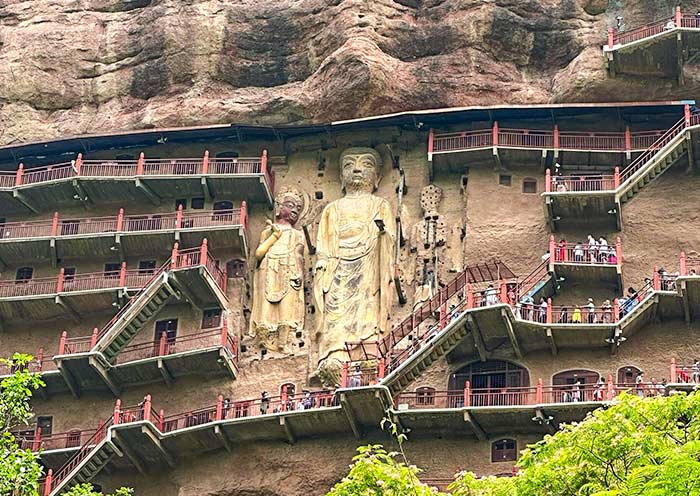
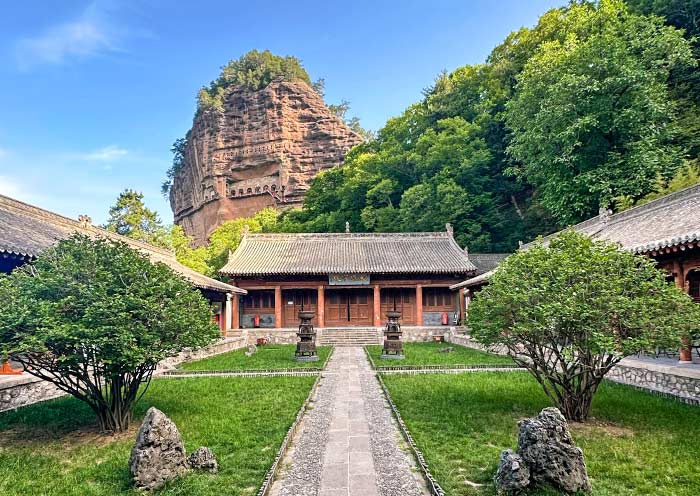
Highlights:
Rich Artwork: Marvel at the intricate sculptures and murals that reflect Buddhist teachings and local artistry.
Historical Context: Understand the significance of the grottoes as a pilgrimage site and cultural hub.
Warm up to Climb: Some of theGrottoes in China are carved into cliffs as Buddha Caves overlooking the world. To admire the intricate carvings you would need to climb some of the steep ladders.
6. Qinghai lake, Qinghai: Spiritual Haven and Natural Wonder along Silk Road
- Location: Qinghai Province, China
- Distance from Xining city center: Approximately 70 miles (113 km)
Known for its stunning beauty, Qinghai Lake served as Xining'slandmark and must-visit attraction for travelers along the Silk Road, symbolizing both a natural respite and a spiritual haven.
Today, nature lovers and adventurers can enjoy outdoor activities against this breathtaking backdrop of this attraction, reminiscent of the peaceful pauses taken by ancient merchants. And Chaka Salt Lake is also the biggest Salt Water Lake in China.


Highlights:
Breathtaking Scenery: Enjoy panoramic views of the lake against the backdrop of the surrounding mountains.
Cultural Significance: Discover local Tibetan culture and traditions that thrive in this picturesque setting.
Outdoor Activities: Engage in cycling, hiking, flower viewing, and bird-watching around the lake.
7. Zhangye Danxia Landform, Gansu: Captivating Silk Road Attraction Resembles Strawberry Cake
- Location: Zhangye, Gansu Province, China
- Distance from Zhangye city center: Approximately 22 miles (35 km)
This Silk Road Attraction, unqiue Landform of Zhangye boasts stunning geological formation showcases the colorful landscapes that travelers along the Silk Road would have encountered, symbolizing the beauty of nature.
Do you think ancient traders would have marveled at the striking scenery along their journeys through these marvelous attractions along the Silk Road?
While a hike through these vibrant formations might not be possible like it was for the Silk Road merchants in the old days for the preservation of the nature, there are quite a few well-pisitioned observation decks scattered throughout the attraction. You would have a stunning panoramic view of the dazzling landform that looks like layers of strawberry cake.

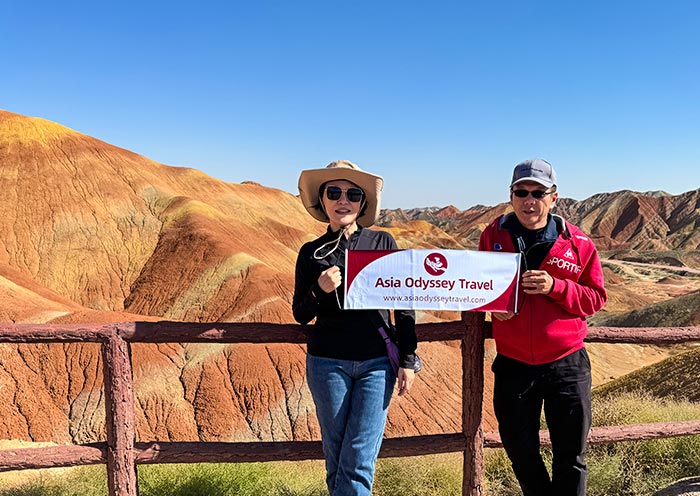
Highlights
Unique Geology: Explore the vibrant colors and unique formations that have fascinated visitors and traders alike.
Photography Opportunities: Capture breathtaking images of the landscape, especially at sunrise and sunset.
Cultural Stories: Learn about the local myths and legends associated with these magical landform.
8. Mo Gao Caves, Gansu: Treasure Trove of Man Kind, Must-Visit Silk Road Attraction
- Location: Dunhuang, Gansu Province, China
- Distance from Dunhuang city center: Approximately 25 miles (40 km)
The Mogao Caves are a UNESCO World Heritage site that holds invaluable art and history, showcasing the religious and artistic influences brought by Silk Road trade.
Admittedly, some of the best pieces were brutally taken by foreigner explorers in the early 1900s. However, the Mogao Caves remain one of the best-preserved historical attractions in China, with extensive collections accumulated over centuries.
Not all relics here are spiritually related at this Silk Road Attraction, some are purely artistic, while others hold significant historical value like Mo Gao Manuscripts(莫高遗书).
This is probably the only Grottoes in China that require booking more than 40 days in advance. The reputation of this Silk Road attraction speaks for itself.
More importantly, the Mogao Caves could be one of the most well-managed Silk Road attractions in DunhuangNorthwest China. Though limitations and regulations do exist, visiting the Mogao Caves in is a must-do experience when traveling along the Silk Road route. You will have a chance to explore these cultural treasures of mankind.
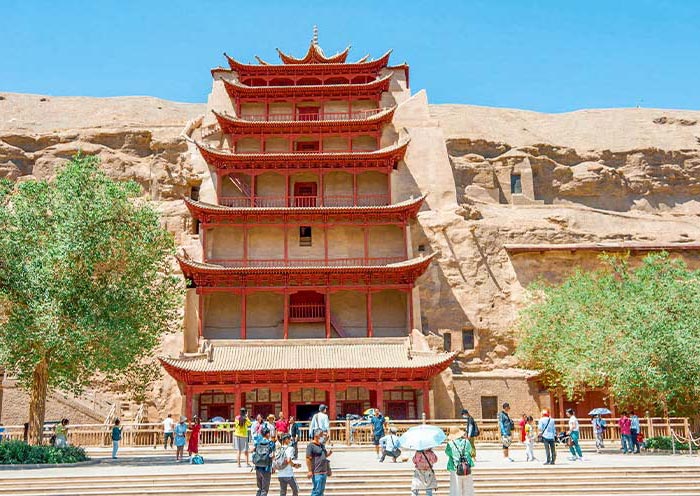
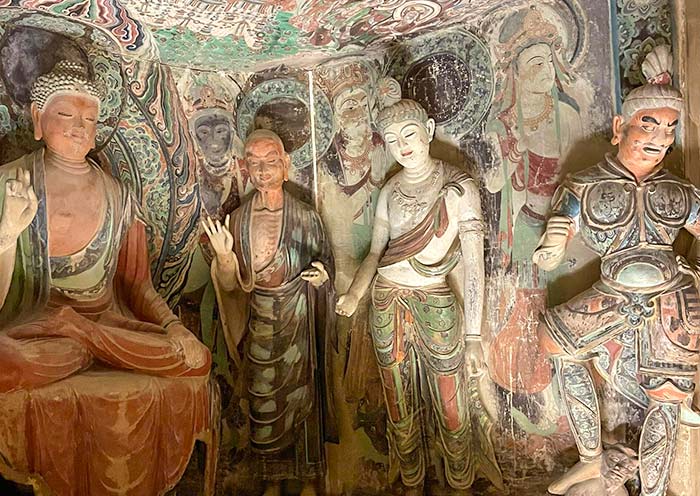
Highlights:
Buddhist Murals: Explore the stunning murals and sculptures that tell the story of Buddhism's spread along the Silk Road.
Historical Significance: Understand the role of the caves as a center of learning and cultural exchange.
Preservation Efforts: Local authorities have put in most dedicated effort preserving this Silk Road attraction. Learn about ongoing efforts to preserve this invaluable cultural heritage.
9. Crescent Moon Spring, Gansu: Desert Sanctuary for Silk Road Travelers for Centuries
- Location: Dunhuang, Gansu Province, China
- Distance from Dunhuang city center: Approximately 4 miles (6 km)
Crescent Moon Spring, located near Dunhuang of Gansu, served as a vital oasis for Silk Road travelers, providing refreshment and respite in the harsh desert landscape. Nestled among the iconic Singing Sand Dunes, the spring continues to attract visitors seeking tranquility and adventure.
Today, gaining popularity alongside the aforementioned Silk Road attraction, the Mogao Caves, Crescent Moon Spring and the Singing Sand Dunes are often packed with tourists in high season.
And honestly as the Best Spring Oasis in this Silk Road region, it would have been packed with travelers in the old days too. You can enjoy a range of activities while experiencing the same sense of relief that ancient traders must have felt when they discovered this hidden gem.
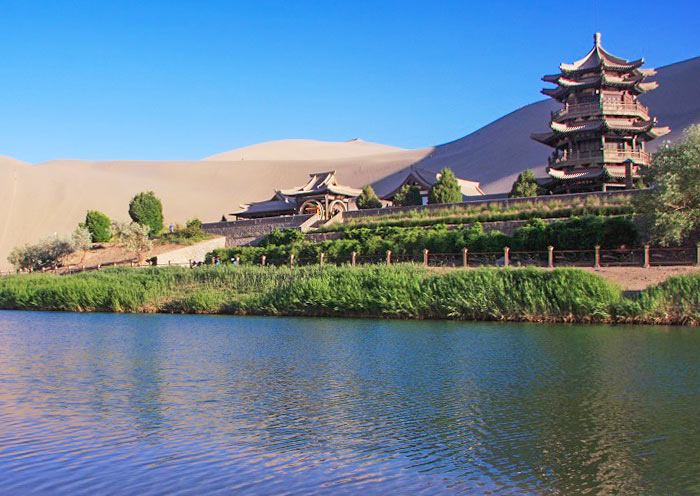
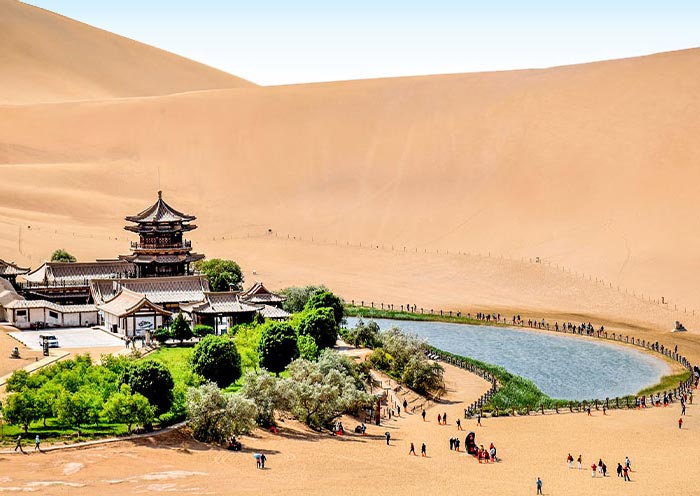
Highlights:
Cultural Significance: Discover how this oasis supported the livelihoods of traders and nomads along the route.
Outdoor Activities: Engage in activities such as sandboarding and camel rides in the nearby dunes.
10. Jiayuguan Pass & Great Wall: Stronghold Safeguarding Silk Road for Centuries
- Location: Jiayuguan, Gansu Province, China
- Distance from Jiayuguan city center: Approximately 5 miles (8 km)
Jiayuguan Pass(嘉峪关) represents the westernmost point of the Great Wall, serving as a fortified stronghold to protect the Silk Road from intrueders and bandits. Its strategic location in Jiayuguan was crucial for safeguarding the trade routes that connected East and West. The ingenious design of this stronghold highlights the effort put in to safeguard communication and exchange along the Silk Road.
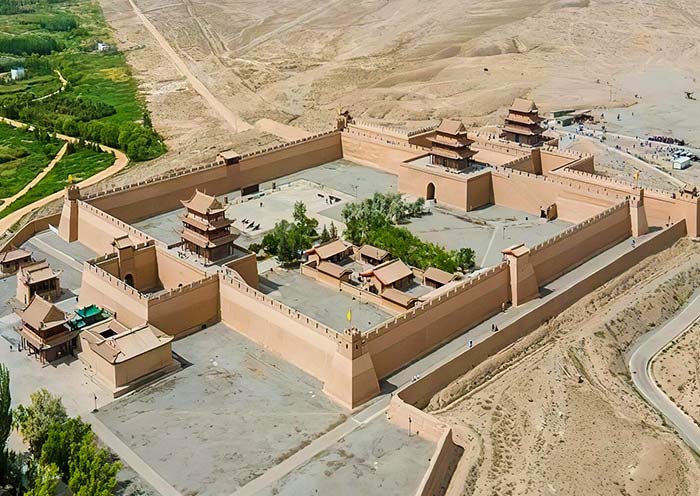
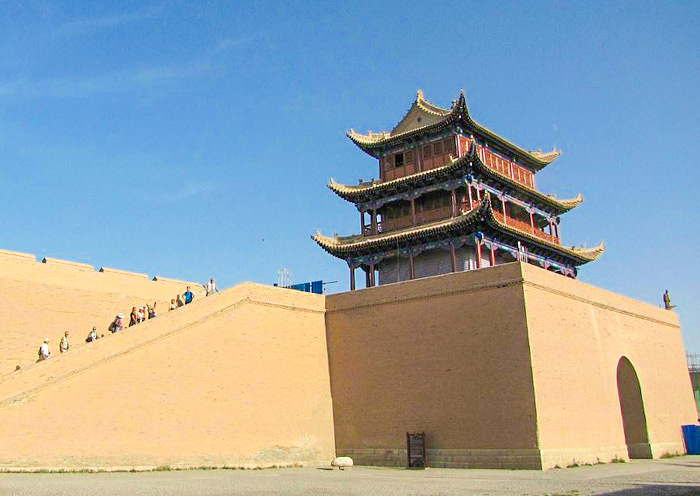
Now, when visiting this Silk Road attraction as a tourist, you can admire the impressive fortifications and gain insight into the strategic defenses that shaped trade in ancient times—much like the merchants who relied on these protections for their Silk Road journeys.
Highlights:
Strategic Importance: Explore the impressive fortifications and learn about their role in safeguarding trade routes.
Historical Insights: Discover the stories of battles and trade that shaped the region.
Visitor Experience: Enjoy interactive exhibits that bring the history of the pass to life. Light show and tour are available at this Silk Road Attraction for a special travel experience.
11. Naraty Grassland: A Picturesque Pastoral Paradise along Silk Road Route
- Location: Near Yining, Xinjiang Province, China
- Distance from Yining city center: Approximately 47 miles (75 km)
Once a perilous pass on the ancient Silk Road, Naraty Grassland is now celebrated by National Geographic as one of the most beautiful places in the world. In turn, it attracts millions of visitors on their trips to Xinjiang.
Known for its stunning pastoral scenery and rich Kazakh folk customs, this area has been a favored grazing ground since ancient times. Xinjiang's cultural diversity goes beyond the Uyghurs, and the landscapes traversed by the Silk Road encompass more than just deserts and oases.
There are many other notable nomadic cultures, including the Kazakhs, Tajiks, and Tuvans, that flourish in the vast grasslands and plateaus of Xinjiang, with some thriving particularly along the Silk Road.
With its sky-touching vast grasslands, this Silk Road attraction now offers tourists breathtaking landscapes and the vibrant culture of the local nomadic communities to explore.

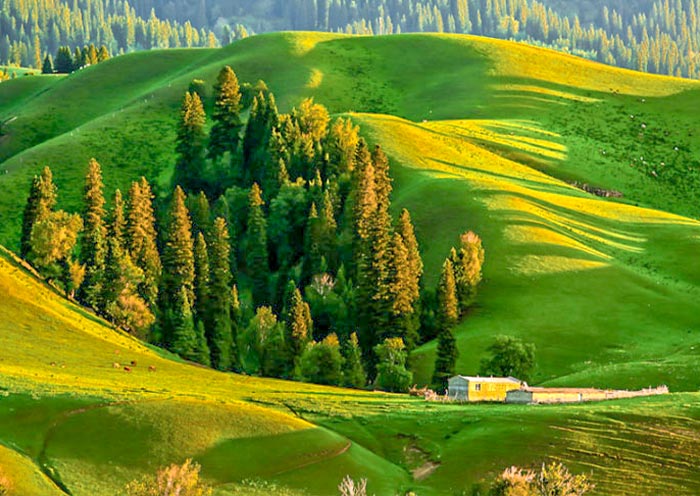
Highlights:
Tianmutai: Witness local herding practices on this vast grazing ground, where the harmony of nature and tradition come to life.
Nomad's Choice: Choose a horse from a stable for a memorable ride through the expansive grasslands, experiencing the land as nomads have for centuries.
Heavenly Terrace: Reach a vantage point that offers stunning sunset views over the grassland and mountains, creating a picturesque backdrop for unforgettable memories.
12. Heavenly Lake of Tianshan Mountains, Xinjiang: A Silk Road Jewel Among Snowy Peaks
- Location: Tianshan Mountains, Xinjiang Province, China
- Distance from Urumqi city center: Approximately 70 miles (113 km)
At Asia Odyssey Travel, we like to think that the Silk Road attraction list is not complete without a snow-capped mountain. Introducing one of the most scenic attractions in Urumqi: Heavenly Lake or Tianshan Tianchi(天山天池), a stunning high-altitude lake nestled in the Tianshan Mountains. This remarkable Urumqi Attractions offers breathtaking views of the surrounding peaks, including the iconic Bogda Mountain.
Easily accessible from Urumqi, Heavenly Lake provides a perfect escape for nature lovers and outdoor enthusiasts.


Highlights:
Serene Waters: Enjoy the tranquil waters of Heavenly Lake while taking in the panoramic views of Bogda Mountain, making it an ideal spot for relaxation and reflection.
Boat Ride or Cable Car: Experience the lake from different perspectives, enhancing your appreciation of the natural beauty.
Hiking: Explore the scenic trails around the lake, offering opportunities to connect with the stunning landscape up close.
Cultural Significance: Discover the rich mythology associated with Heavenly Lake. According to legend, the powerful goddess Xi Wangmu (西王母) resides in a palace within the Tianshan Mountains, and the lake, nicknamed the Jade Pond (瑶池), is said to have served as her spa.
13. Jiaohe Ancient City, Xinjiang: A Window into Silk Road History
- Location: Turpan, Xinjiang Province, China
- Distance from Turpan city center: Approximately 6 miles (10 km)
Jiaohe, meaning"the confluence of two rivers," is strategically positioned on a large, steep plateau that provides formidable natural defenses. As a key city connecting the Central Plains (中原) and the vast regions of the Western Regions (西域) of China, Jiaohe Ancient City played a vital role in the transportation network of the Silk Road. It witnessed the bustling trade along the Silk Road and the exchange and integration of Eastern and Western cultures.
The Jiaohe Acient city Ruins now stands as a must-visit attraction in Turpan, Xinjiang. Visiting this attraction you can catch a glimpse of the lost city of once thriving Silk Road hub.
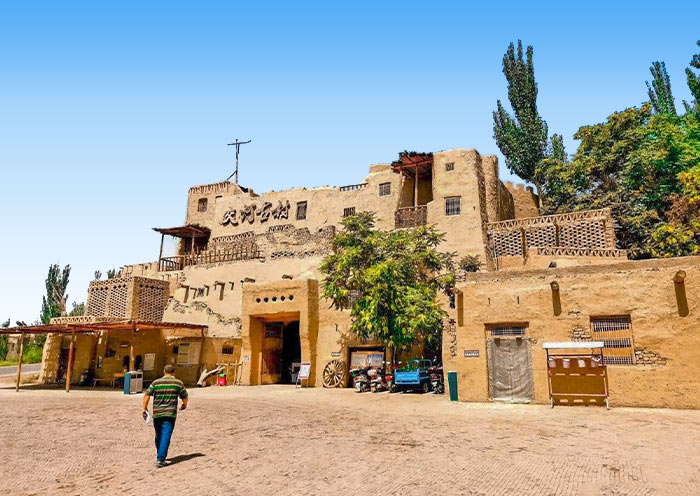
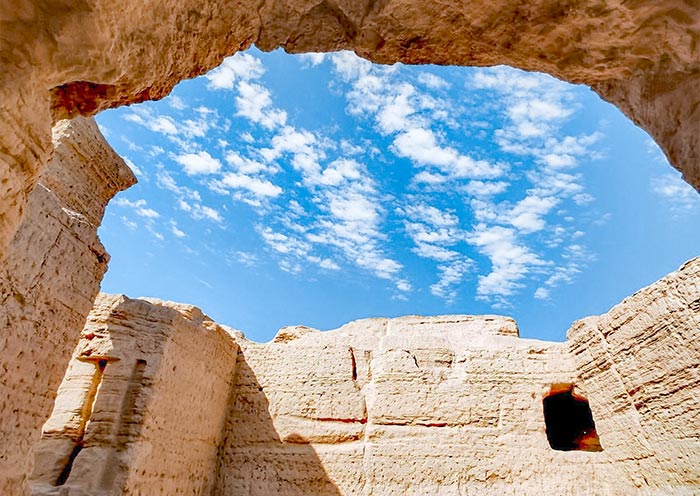
Highlights:
Unique Architecture: Unlike many ancient cities, Jiaohe's structures were carved down into the existing plateau of loess soil. You can see remains of government offices, residential houses, Buddhist stupas, and temples.
Historical Significance: The Ancient City of Jiaohe was established around 2,000 years ago as the capital of the Jushi Kingdom (车师国), one of the 36 kingdoms in the Western Regions. During the Western Han Dynasty, Jiaohe emerged as a crucial hub on the Silk Road.
14. Kashgar Old City: Ever Thriving Silk Road Bazaars
- Location: Kashgar, Xinjiang Province, China
- Distance from Kashgar city center: Approximately 1 mile (1.6 km)
Kashgar Old City is a vibrant showcase of rich history along the ancient Silk Road, featuring well-preserved architecture and a lively cultural heritage. This area serves as a melting pot of influences from various ethnic groups, including Uyghur, Han, Arabic, Hui, Tajiks among others.
So it is a fascinating attraction for travelers seeking to experience the essence of Silk Road Heritage in Xinjiang. Best thing about this Silk Road Highlight is that unlike the Jiaohe Ancient City where there's only relics and ruins left, the Kashgar Old City is still thriving with Top Things to Do in Kashgar.
Visit this long-lasting Silk Road Hub, wander its winding streets, experiencing a blend of ancient traditions and modern life, complete with lively bazaars and vibrant markets that echo the bustling trade of centuries past.
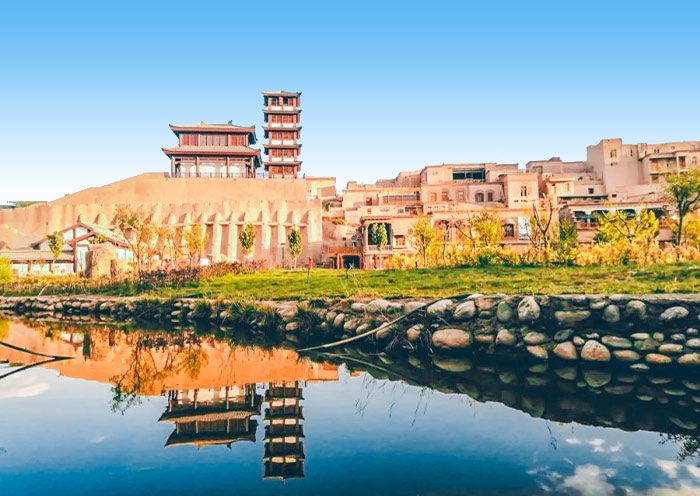

Highlights:
Bazaar Market Experiences: Wander through bustling bazaars filled with local delicacies, textiles, and handicrafts, reminiscent of the lively trade that once characterized the area.
Architectural Wonders: Admire the unique earthen mud-brick architecture throughout the old town, showcasing the region's cultural diversity.
Cultural Exchange: Engage with local artisans and learn about traditional crafts, enhancing your understanding of the area's rich heritage.
15. Kizil Caves - The Earliest Buddhist Grottoes
- Location: Near Kizil, Xinjiang Province, China
- Distance from Kizil city center: Approximately 25 miles (40 km)
The Kizil Caves are among the earliest Grottoes in China, representing the spread of Buddhism along the Silk Road. And surprisingly it's located along the Xinjiang Part of Silk Road Route.
Visitors can marvel at the ancient artistry within the caves while learning about the spiritual significance of the site, echoing the journeys of pilgrims who traveled here in search of enlightenment—some local dwellers and some Silk Road travelers.
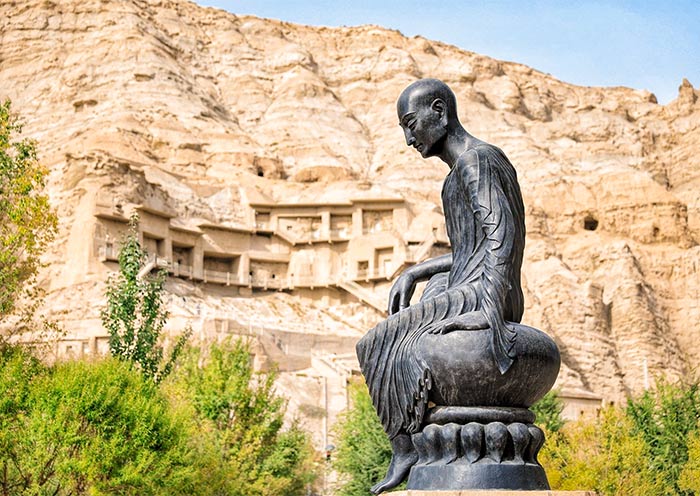
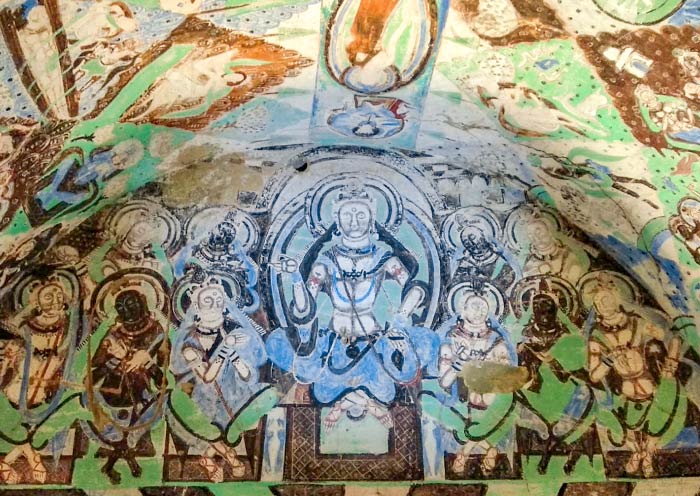
Highlights:
Historical Art: Explore the ancient murals and carvings that reflect the region's religious history and the influence of various cultures along the Silk Road.
Cultural Insights: Understand the role of the Kizil Caves as a center of learning and artistic expression, illustrating the rich cultural exchanges facilitated by Silk Road trade.
16. Taklamakan Desert: Once The Sand Sea of Death for Silk Road Travelers
- Location: Xinjiang Province, China
- Distance from Kashgar city center (to northern edge): Approximately 40 miles (64 km)
Once upon a time, you would have to rely on camels to have even a mere chance of making it through the arid desert if you ever wanted to seek your fortune along the Silk Road. Even with the most efficient water system, the Karez Water System, making oases possible, the desert has always been cruel, at least to its human visitors.
The Taklamakan Desert, often referred to as the"Sea of Death," is the largest desert in China and a pivotal area along the Silk Road. Its vast, shifting sands have served both as a barrier and a passage for ancient Silk Road traders. Yet travelers persevered over the centuries.
Times are different now. With the Silk Road being revived and implemented in recent years, the travel experience for tourists along the route has become more pleasant while keeping its grandeur intact. You can explore this remarkable landscape while reflecting on the challenges and triumphs faced by those who crossed its expanse centuries ago on a glorious Xinjiang road trip.

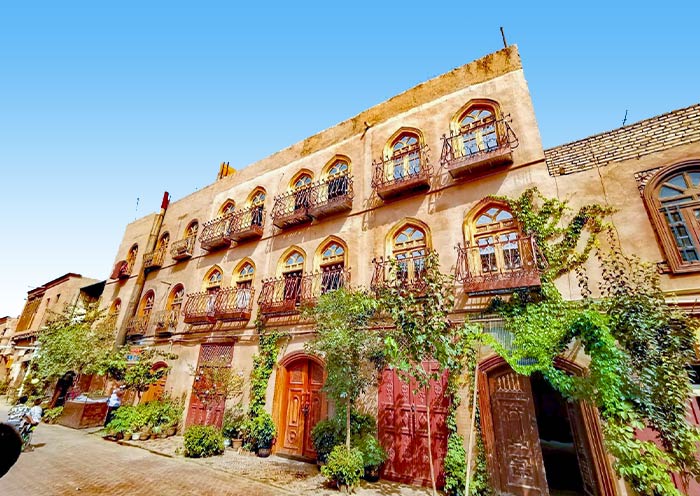
Highlights:
Dramatic Landscapes: Experience the stunning vistas of dunes and rugged terrain, offering a unique opportunity for photography and adventure.
Cultural Significance: Learn about the historical importance of the desert in trade routes and how it shaped the journeys of countless travelers.
Road Trip & Adventures: Take a desert road trip, engage in activities like camel trekking and desert tours, immersing yourself in the environment that once tested the limits of ancient caravans.
How to Plan a Road Trip in Xinjiang? (2025 Routes & Maps)
How to Plan a China Silk Road Tour
Planning a tour along the historic Silk Road in China offers a captivating journey through time, bridging ancient history with the vibrant diversity of today. Whether you have a few days or a couple of weeks, there are various itineraries to suit your schedule and interests.
Short Stay: 4-6 Days
For those with limited time, a 4-5 day tour focusing on 1-2 key Silk Road cities is ideal. A popular choice is Xi'an and Dunhuang, which showcase the rich history and cultural significance of the Silk Road. Alternatively, exploring Dunhuang and Zhangye offers a combination of ancient sites and stunning natural landscapes.
Week-Long Adventure: 7-8 Days
With a week to spare, delve deeper into the regions of Gansu, Qinghai, or a combined Gansu-Xinjiang route. Each offers unique highlights:
- Gansu Silk Road: Travel from Lanzhou to Dunhuang, visiting landmarks like Zhangye Danxia National Geological Park and the Mogao Caves.
- Qinghai Silk Road: Embark on a scenic journey from Xining through Qinghai Lake to Dunhuang, exploring less-traveled paths and breathtaking landscapes.
- Gansu and Xinjiang Silk Road: Experience a blend of cultural heritage and dramatic scenery from Dunhuang to Urumqi, ending in the historical city of Kashgar.
Classic Route: 10-12 Days
For an extended exploration, the 10-12 day itinerary from Xi'an to Kashgar is perfect, taking you through significant Silk Road cities and offering a comprehensive understanding of this ancient trade route's impact.
Deep Exploration: 13-15 Days
If you have up to two weeks, consider a thorough exploration that not only covers the main Silk Road cities but also extends to other parts of China like Beijing, Shanghai, or even Tibet, enriching your experience of China's diverse cultures and landscapes.
Asia Odyssey Travel: Your Best Caravans Leader along Silk Road
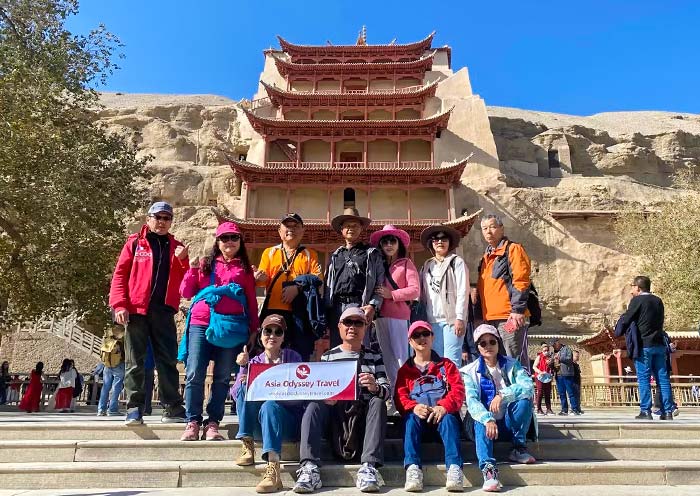

- Genuine Service: Not just an agency—we are your travel companions.
- Exclusive Access: Secure your tickets and accommodations even in high season.
- Authentic Experience: Best local guides with cultural insights.
- Travel Made Easy: Flights, hotels, activities—all taken care of!
- Skip the Tourist Routine: Avoid all tourist traps and travel down to earth
- 24/7 Support: Always on-line for your peace of mind
Asia Odyssey Travel, leading your China Adventure Since 2010. What's your travel idea? Let's talk!
